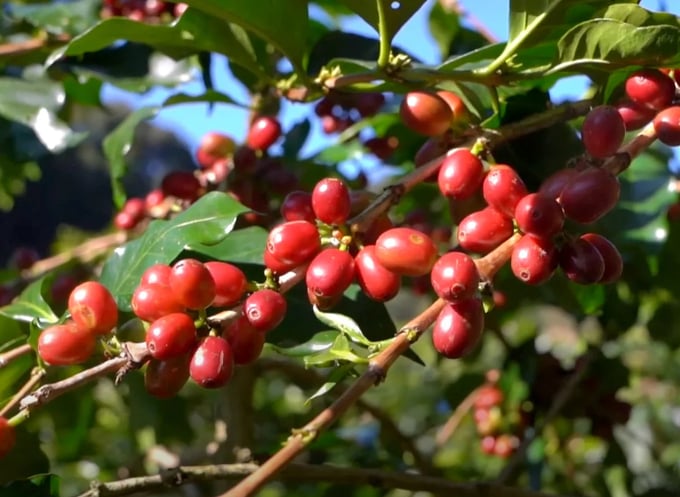November 25, 2025 | 10:31 GMT +7
November 25, 2025 | 10:31 GMT +7
Hotline: 0913.378.918
November 25, 2025 | 10:31 GMT +7
Hotline: 0913.378.918

Vietnam's coffee production is estimated to decrease by 20% in the 2023/2024 crop year. Photo: Son Trang.
In July, coffee prices in the Central Highlands have consistently remained high, above VND 120,000/kg, with some instances reaching VND 130,000/kg. Compared to the same period last year, current coffee prices are twice as high.
High global coffee prices, coupled with a supply shortage, are the main reasons keeping Vietnamese coffee prices elevated in recent months.
The Agency of Foreign Trade (Ministry of Industry and Trade) reported that in early July 2024, global prices for Robusta and Arabica coffee surged due to concerns that drier-than-usual conditions could adversely affect coffee crops in Brazil and Vietnam. On July 11, the price of Robusta coffee for September 2024 delivery on the London exchange hit a record high of $ 4,681/ton. On the same day, Arabica coffee prices on the New York exchange reached $ 5,629/ton.
The Ministry of Agriculture and Rural Development estimates that Vietnam's coffee production for the 2023/2024 crop year will be 1.47 million tons, a 20% decrease compared to the 2022/2023 crop year. This will be the lowest production in the past four years.
In the first nine months of the 2023/2024 crop year (from October 2023 to September 2024), Vietnam has exported nearly 1.26 million tons of coffee, a decrease of more than 11% compared to the same period in the 2022/2023 crop year. This export volume is equivalent to 86% of the 2023/2024 crop year's production.
Thus, excluding any leftover stock from the 2022/2023 crop year, Vietnam currently has only about 210,000 tons of coffee available for export in the remaining three months of the 2023/2024 crop year (from July to September), until the new harvest season begins in October.
In reality, there is almost no leftover stock from the 2022/2023 crop year, as noted by Mr Do Ha Nam, Vice President of the Vietnam Coffee and Cocoa Association (VICOFA). From May to June 2023, Vietnam experienced a shortage of coffee for export, a situation that extended into the beginning of the 2023/2024 crop year, forcing many businesses to use current crop year coffee to fulfil export orders from the previous crop year.

Drying coffee on a farm in the Central Highlands. Photo: Son Trang.
Recent coffee export volumes clearly reflect the coffee shortage situation in Vietnam. In May 2024, Vietnam exported 79,000 tons of coffee, a decrease of 47.8% in volume compared to April 2024 and a 47% decrease compared to May 2023. In June 2024, Vietnam exported 70,000 tons of coffee, an 11.5% decrease compared to May 2024 and a 50.4% decrease compared to June 2023.
With the coffee supply nearly depleted, Vietnam's coffee exports in the remaining three months of the 2023/2024 crop year are expected to continue declining. This could lead to higher coffee prices as demand remains strong. European importers are increasing their coffee purchases due to the trend of stockpiling before complying with the European Union’s Deforestation Regulation (EUDR), which takes effect on January 1,2025.
Vietnam's coffee production is not only decreasing in the 2023/2024 crop year but is also expected to decline further in the 2024/2025 crop year.
Extended heat in the first half of this year has significantly affected many coffee farms in the Central Highlands. Furthermore, many farms in the region have been impacted by pests, particularly mealybugs.
Mr Do Van Tan, a farmer in Thon 6, Hoa Ninh Commune, Di Linh District, Lam Dong Province, stated that his family cultivates over 1 hectare of coffee, with about 30% of the area being affected by mealybugs. Mealybugs are most active at the end of the dry season and the beginning of the rainy season. They suck the sap from the plant, causing new shoots, branches, and leaves to dry up, leading to flower drop, premature fruit drop, and branch death. The infestation of mealybugs also facilitates the growth of sooty mould on branches, leaves, and fruits, reducing the plant’s ability to photosynthesize and significantly decreasing coffee yield.
According to VICOFA, adverse weather, combined with outbreaks of mealybugs and red spiders in many coffee-growing provinces, could lead to a 15% to 20% reduction in Robusta coffee production for the upcoming crop year. VICOFA estimates that Vietnam’s Robusta coffee production for the 2023/2024 crop year is around 26.7 million bags (1 bag = 60 kg). If the reduction occurs as predicted for the 2024/2025 crop year, Robusta production could fall to between 21.4 and 22.7 million bags, significantly lower than the USDA’s estimate of 27.85 million bags.
Translated by Hoang Duy

(VAN) An Giang promotes supply-demand connections, standardizes quality and builds value chains, creating a foundation for sustainable bird’s nest development and aiming to expand exports.
/2025/11/24/5339-4-nongnghiep-075331.jpg)
(VAN) Recently, the conference on 'Sustainable Fisheries Linkage Chain - Tilapia for Export' took place in Tien Hai commune, Hung Yen province.
/2025/11/21/4309-2-153400_128.jpg)
(VAN) Green and low-emission rice is paving the way for Vietnamese rice to enter high-end markets, marking the beginning of a transformation journey toward greening and elevating the national rice brand.

(VAN) ‘Right to Win’ outlines a national action plan that shapes a new vision for Viet Nam’s agriculture in an era of renewal and global integration.

(VAN) Lam Dong’s farmed sturgeon output this year is expected to reach 2,300 tons, worth VND 450 billion, affirming the brand’s position on the market.

(VAN) A surge in Ukrainian egg exports, largely driven by soaring sales to the UK over the last few years, has notably pushed up egg prices on the domestic market.

(VAN) The price of Arabica Catimor coffee in Quang Tri is currently at VND 25,000–27,000/kg (fresh cherries), the highest level ever recorded